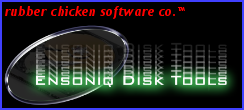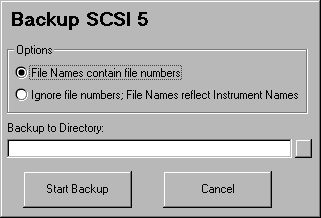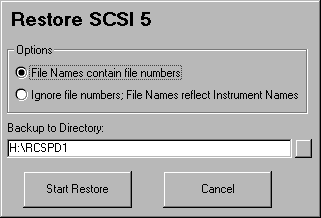
 |
Backing up and Restoring SCSI Drives Back to How To's Table of Contents |
Methods
-Right-Click in Ensoniq Explorer Directory List (in Ensoniq Mode when SCSI is selected), select Backup SCSI Drive
-Right-Click in Ensoniq Explorer Directory List (in Ensoniq Mode when SCSI is selected), select Restore SCSI Drive


This is for file-by-file backup of your SCSI drive. Takes the files one by one off your drive, and makes File Images under the proper DOS directories on your DOS drive, in the same configuration as organized on your SCSI drive. It is recommended that you use a fresh drive, as well as with the Restore command.
We wanted to improve on the Giebler EDM method of backing up - EDM’s method is to make a big proprietary .EFE file (notice that with EDM it doesn’t become EFA with ASR - it stays EFE). The problem with that is that you can’t view the contents nor modify it.
Our method is an improvement. Within the destination directory, Disk Tools creates an identical directory structure within DOS. This way you can edit the directory placements and move the instruments around as you please.
There are two methods of backing up and restoring.
File Numbers
This looks a little tricky, but there are reasons for it. Since DOS has no “file numbers” within a directory, but the Ensoniq file system does, what we do is make the File Image file names the file number (e.g.; if MR BRASS is File #2, it becomes 2.efa). The instrument names are kept intact. In the case of directories, there are two possible problems - 1) DOS file names are 8 characters, and that is not enough for a 12 character Ensoniq directory, and 2) directories are stored within file numbers as well. So, we name the directory with a number as well (for example, 3), and store the name in a file with the extension *.rcs.
File Names
This does what you would expect - extract each file and name it under DOS with a name that is similar to the actual Instrument Name. This way you can identify the file in DOS easier. However, the .RCS extension for the directory are retained, because otherwise you would lose the last 4 letters in the directory name, because DOS only permits 8 character directory names. The .RCS file contains the full Ensoniq 12-character name, for reference upon Restore.
Remember that if you back up using this method, you will lose the order in which the files are placed within the directory. Files are given the appropriate extension according to their file type (ASR-type gets .efa, EPS gets .efe).You may make multiple selections, and copy to a single DOS directory.
Please see Page 8 (Ensoniq Explorer section) for further information about what Ensoniq Disk Tools requires from your computer to work via SCSI.
SCSI Mapper
When perform the Restore SCSI Drive command, Ensoniq Disk Tools allows you to change certain aspects of the files written to the SCSI Drive, in order to fit a specific requirement.
Bank Mapping
You can change the Disk Label and the SCSI numbers on each Bank file that is written. This can preserve the locations the Bank file points to, so it will work with the new SCSI ID of the drive and the new Disk Label. Each SCSI ID can be mapped to another.
File Type Conversions
You are given the option of translating each file type to correspond to another, ensuring the best possible compatibility with the Ensoniq sampler that will be using it.
For more information see Page 12 on converting File-types.